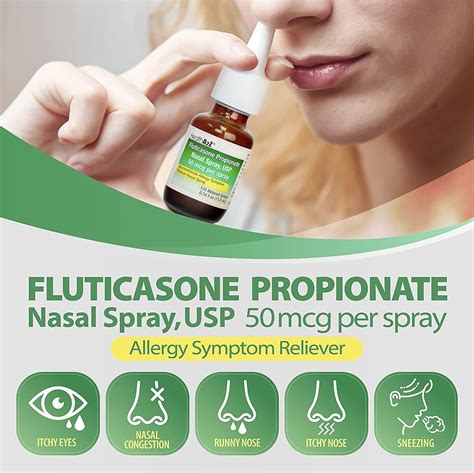Intro
Discover how Fluticasone works to relieve allergy symptoms, reduce inflammation, and improve respiratory health with its anti-inflammatory properties and corticosteroid benefits.
Fluticasone is a type of corticosteroid that is widely used to treat various inflammatory conditions, including asthma, allergies, and skin disorders. It is a synthetic steroid that is designed to mimic the effects of cortisol, a naturally occurring hormone produced by the adrenal gland. Fluticasone works by reducing inflammation and swelling in the body, which can help to alleviate symptoms such as itching, redness, and breathing difficulties.
The importance of fluticasone cannot be overstated, as it has revolutionized the treatment of many chronic conditions. For example, inhaled fluticasone is commonly used to treat asthma, which affects millions of people worldwide. By reducing inflammation in the airways, fluticasone can help to improve lung function, reduce symptoms, and prevent exacerbations. Similarly, topical fluticasone creams and ointments are used to treat skin conditions such as eczema and psoriasis, which can have a significant impact on a person's quality of life.
Fluticasone is also used to treat allergic rhinitis, which is a common condition that affects millions of people worldwide. Allergic rhinitis is characterized by symptoms such as nasal congestion, sneezing, and itchy eyes, which can be debilitating and disrupt daily life. Fluticasone nasal sprays are highly effective in reducing these symptoms, allowing people to breathe easily and live normally. Overall, fluticasone is a highly effective medication that has improved the lives of millions of people worldwide.
How Fluticasone Works

The exact mechanism of action of fluticasone is not fully understood, but it is thought to involve the inhibition of key enzymes involved in the inflammatory response. For example, fluticasone has been shown to inhibit the activity of phospholipase A2, an enzyme that is involved in the production of pro-inflammatory eicosanoids. By reducing the production of these mediators, fluticasone can help to alleviate symptoms and prevent tissue damage.
Benefits of Fluticasone
The benefits of fluticasone are numerous and well-documented. Some of the key advantages of using fluticasone include: * Rapid onset of action: Fluticasone can start to work within hours of administration, providing quick relief from symptoms. * High efficacy: Fluticasone is highly effective in reducing inflammation and alleviating symptoms, making it a popular choice for treating chronic conditions. * Low risk of side effects: Fluticasone is generally well-tolerated, with a low risk of serious side effects. * Convenience: Fluticasone is available in a range of formulations, including inhalers, nasal sprays, and topical creams, making it easy to use and convenient.Types of Fluticasone

Side Effects of Fluticasone
While fluticasone is generally well-tolerated, it can cause some side effects, particularly when used at high doses or for prolonged periods. Some of the common side effects of fluticasone include: * Thinning of the skin: Topical fluticasone can cause thinning of the skin, particularly when used on the face or neck. * Weight gain: Oral fluticasone can cause weight gain, particularly when used at high doses. * Mood changes: Fluticasone can cause mood changes, such as anxiety, depression, or irritability. * Increased risk of infection: Fluticasone can increase the risk of infection, particularly when used at high doses or for prolonged periods.Contraindications of Fluticasone

Interactions with Other Medications
Fluticasone can interact with other medications, including: * Other corticosteroids: Using fluticasone with other corticosteroids can increase the risk of side effects. * Anti-inflammatory medications: Using fluticasone with anti-inflammatory medications can increase the risk of stomach ulcers and bleeding. * Antifungal medications: Using fluticasone with antifungal medications can increase the risk of fungal infections.Dosage and Administration of Fluticasone

Monitoring and Follow-up
Regular monitoring and follow-up are essential when using fluticasone, particularly when used at high doses or for prolonged periods. This includes: * Monitoring for side effects: Regular monitoring for side effects, such as thinning of the skin or weight gain, is essential to minimize the risk of complications. * Monitoring for efficacy: Regular monitoring for efficacy, such as measuring lung function or assessing symptoms, is essential to determine the effectiveness of the medication. * Adjusting the dosage: The dosage of fluticasone may need to be adjusted based on the individual's response to the medication and the presence of side effects.What is fluticasone used for?
+Fluticasone is used to treat a range of conditions, including asthma, allergies, and skin disorders.
How does fluticasone work?
+Fluticasone works by reducing inflammation and swelling in the body, which can help to alleviate symptoms such as itching, redness, and breathing difficulties.
What are the side effects of fluticasone?
+The side effects of fluticasone include thinning of the skin, weight gain, mood changes, and increased risk of infection.
In summary, fluticasone is a highly effective medication that is used to treat a range of conditions, including asthma, allergies, and skin disorders. It works by reducing inflammation and swelling in the body, which can help to alleviate symptoms and prevent tissue damage. While fluticasone is generally well-tolerated, it can cause some side effects, particularly when used at high doses or for prolonged periods. Regular monitoring and follow-up are essential to minimize the risk of complications and ensure the effectiveness of the medication. We invite you to share your thoughts and experiences with fluticasone, and to ask any questions you may have about this medication.
